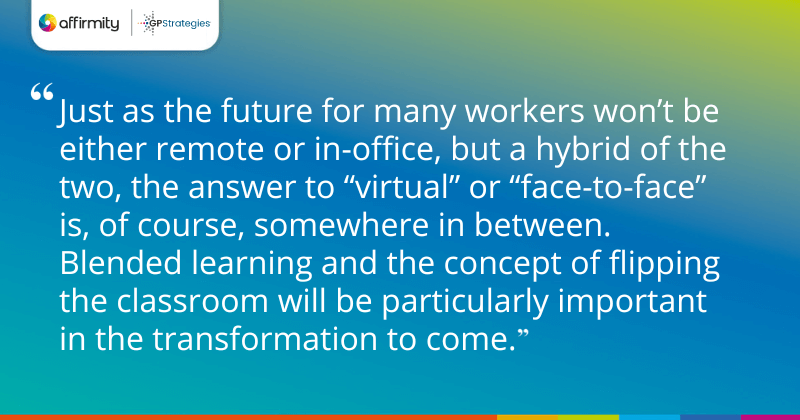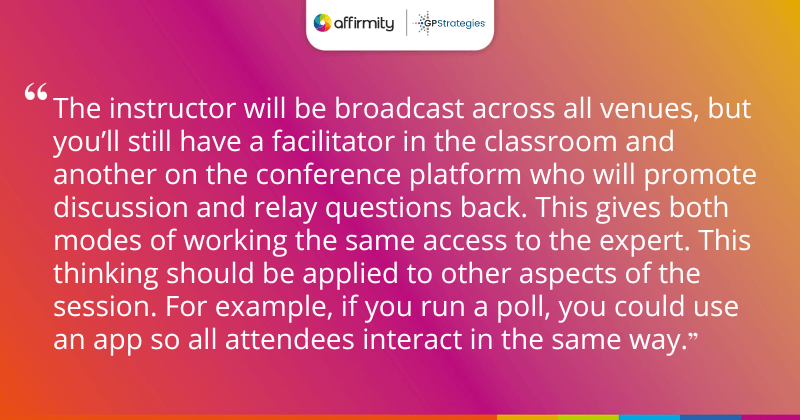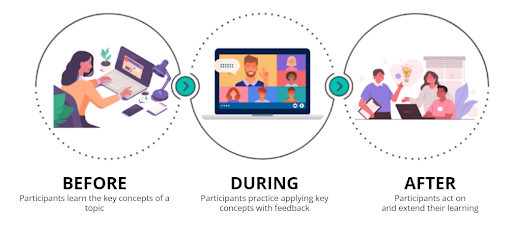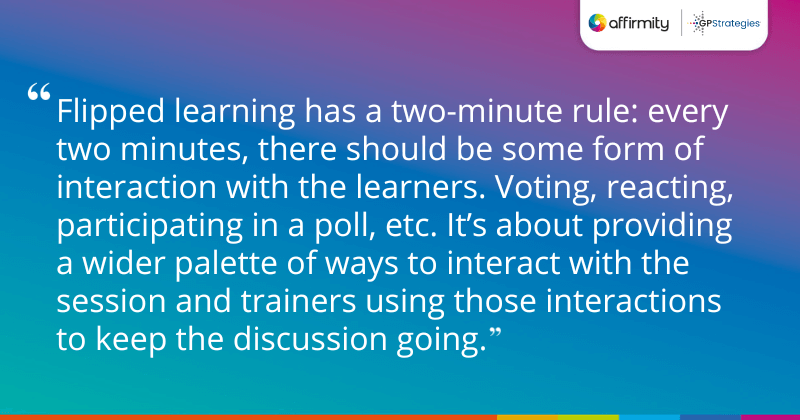For most, 2020 will be remembered as a year to forget. But for one group—digital learning designers—it at least represented an exciting opportunity. In this article, Nic Girvan, Global Director of Learning and Delivery at GP Strategies (an Affirmity inclusion training partner), looks back on lessons we can all learn from a year of enforced remote working and the rather less clear-cut working regime that followed.
Your digital DE&I learning program is no longer shiny and new. Employees are torn between remote and office working, and learning professionals are stuck there with them: do they stay the course with digital training programs, or should they go back to doing what they know?
The pandemic may have finally forced organizations to go digital for their learning, but that move wasn’t easy for everyone. Some things were done in a rush. Much of it was done without taking advantage of the full potential of digital learning formats. Many made do with slideshows and notes hastily dropped into an authoring tool.
This approach was fine in a pinch, but just as the world at large no longer sees the novelty in a video call catchup with friends and family, your digital inclusion learning approach needs to be better if it’s going to remain an important pillar of your approach.
Because just as the future for many workers won’t be either remote or in-office, but a hybrid of the two, the answer to “virtual” or “face-to-face” is, of course, somewhere in between. Blended learning and the concept of flipping the classroom will be particularly important in the transformation to come.
Here are four steps that will help you shake things up and stay relevant.
KEY READING FROM THE BLOG | ‘Reinforcing DE&I With Blended Learning: How to Deliver Training That Actually Lasts [Q&A]’

1) Create Learning That Serves Sociological Needs in Addition to Technological Ones
Our staple learning format has become live-virtual sessions. Using a range of technologies to deliver not just instructor-led learning, but a blend of other approaches such as digital whiteboards, breakout rooms, polls, videos, and live chat. Trying lots of different things in this way really helps to serve a range of learning styles—a far cry from that “slideshow to authoring tool” pipeline.
But even this leaves room for trying something completely new! During 2020, we decided to repackage our live-virtual allyship, race awareness, and inclusive behaviors material into a “virtual escape room” format. Functionally, it’s a live-virtual environment and we even begin the session as we would any other Zoom session.
However, we gave it a narrative twist: the session gets “hacked”, and the participants must work together in breakout groups and learn about the content through the activities within the room. However, more than that, the extent to which they demonstrate inclusive behaviors during the course of the session is something we’re able to discuss during the debrief.
This kind of approach helps you make the concepts so much more tangible. Ultimately, the virtual escape room idea was a perfect fit for the circumstances we found ourselves in: everyone was really feeling that need to connect with people and with others.

2) Think About How You’re Going to Give Hybrid Workers the Same Quality of Experience
Hybrid working is a reality for many organizations now. On any given day, there could be some employees in the office and some working from home. It’s likely that your hiring practices have changed along with people’s working patterns. For example, you may have teams that are more dispersed than they previously were. All of this makes mandatory, in-person training less realistic—enforcing it is unlikely to win you any friends.
At first glance, the solution to this might be to run the in-person session and give remote workers access to it via a way to dial in. But is this giving them a good experience? Surely not! They’re missing out on the conversations in the room, and getting a less engaging experience overall.
The key here is to work with facilitators and create a more even playing field for both in-person and virtual attendees. Removing the instructor from the classroom and having them dial in helps achieve this. The instructor will be broadcast across all venues, but you’ll still have a facilitator in the classroom and another on the conference platform who will promote discussion and relay questions back. This gives both modes of working the same access to the expert. This thinking should be applied to other aspects of the session. For example, if you run a poll, you could use an app so all attendees interact in the same way.
HANDPICKED FOR YOU | ‘8 of the Most Common Challenges for Diversity Equity & Inclusion Today’
3) Embrace Flipped Learning and Help Your Learners Apply New Knowledge
There will always be a place for trainers and subject matter experts. However, we also know that many people actively seek out and learn things through platforms like YouTube and even Tik Tok. Ignore this trend of enthusiastic learners perfectly conditioned for video learning at your peril! As a result, trainer and SME roles have to evolve into a new space—namely, flipped learning.
Flipped learning is the idea of reversing the roles of classroom events and embedded resources, and in a sense, reversing the roles of trainer and learner. The resource should be given before the event rather than after, giving the learner the opportunity to learn the foundational information before the live virtual or face-to-face session.

In that session, the trainer’s time doesn’t need to be spent on the basics. It can then be spent on running more of a ‘working clinic’ in which learners ask questions that really drill into what the topic means for them in their day-to-day work and to discuss any issues they may have related to it.
There’s a real psychological benefit to this structure, especially for diversity, equity, and inclusion topics. Traditionally, you would educate your employees and put them back in a work context where they quickly lose momentum. These are big issues, and if they’re just now engaging with them, being unable to discuss their practical concerns and request clarification can often be overwhelming. Flipped training ensures they get to safely share those discussions with their peers as part of the process.
MORE ON AUDIENCE-LED LEARNING PROGRAMS | ‘One Size Doesn’t Fit All: Why Inclusion Training Must Always Be Tailored to Your Audience’

4) Focus On Getting Flipped Learning Right
This process will require a cultural shift. You may reasonably ask “people don’t work for free, so won’t they just skip the resources?” Possibly, but only if you continue to treat the resources as an optional add-on. Set the agenda for a new inclusion training culture by scheduling the pre-work in people’s diaries just as you would the training session. Let people know why you’re doing this, why it’s a requirement, and why they should be excited about it.
Another area of concern may be how easily accessible your resources are to employees in the field or on the shop floor, without reliable Wi-Fi or a company-allocated device. A microlearning approach could be more suitable for this audience. You could break down larger topics and distribute them to personal devices via chat programs such as WhatsApp, or show them in team huddles and other group gatherings ahead of the training session.
Successful flipped learning also relies greatly on the skills of your trainer, who needs to be able to facilitate conversation and ensure everyone participates. This isn’t to say that people should be forced to contribute verbally if they’re not comfortable doing so, either because of their personality or because culturally that expectation isn’t there. However, the trainer should look for opportunities to bring in a wider range of learners via other channels such as whiteboards and chat boxes throughout the session.
Flipped learning has a two-minute rule: every two minutes, there should be some form of interaction with the learners. Voting, reacting, participating in a poll, etc. It’s about providing a wider palette of ways to interact with the session and trainers using those interactions to keep the discussion going.
Conclusion: It’s Time to Flip Thinking as Well as Classrooms
By using the best tech suitable for hybrid environments and focusing on giving learners the best experience whether they’re in the room or in front of a screen via a flipped-classroom approach, you stand to build a more personal, authentic, and practical learning environment.
To learn more about how to expertly combine digital, virtual, and face-to-face learning solutions to cultivate engagement and curiosity in your learners, contact us today.
 About the Author
About the Author
Nic Girvan is the Global Director of Learning and Delivery at GP Strategies. She’s an expert in business psychology, adult learning practice, modern leadership, and DE&I transformation. In her role, she emphasizes that it’s only possible for organizational development strategies to result in measurable change when innovative and enhanced methods of delivery are fully embraced.
